Category: Critical Care
Posted: 9/30/2013 by Haney Mallemat, MD
(Updated: 10/1/2013)
Click here to contact Haney Mallemat, MD
The efficacy of epinephrine during out-of hospital cardiac arrest has been questioned in recent years, especially with respect to neurologic outcomes (ref#1).
A recent study demonstrated both a survival and neurologic benefit to using epinephrine during in-hospital cardiac arrest when used in combination with vasopressin and methylprednisolone.
Researchers in Greece randomized 268 consecutive patients with in-hospital cardiac arrest to receive either epinephrine + placebo (control group; n=138) or vasopressin, epinephrine, and methylprednisolone (intervention arm; n=130)
Vasopressin (20 IU) was given with epinephrine each CPR cycle for the first 5 cycles; Epinephrine was given alone thereafter (if necessary)
Methylprednisolone (40 mg) was only given during the first CPR cycle.
If there was return of spontaneous circulation (ROSC) but the patient was in shock, 300 mg of methylprednisolone was given daily for up to 7 days.
Primary study end-points were ROSC for 20 minutes or more and survival to hospital discharge while monitoring for neurological outcome
The results were that patients in the intervention group had a statistically significant:
probability of ROSC for > 20 minutes (84% vs. 66%)
survival with good neurological outcomes (14% vs. 5%)
survival if shock was present post-ROSC (21% vs. 8%)
better hemodynamic parameters, less organ dysfunction, and better central venous saturation levels
Bottom-line: This study may present a promising new therapy for in-hospital cardiac arrest and should be strongly considered.
Follow me on Twitter (@criticalcarenow) or Google+ (+criticalcarenow)
Category: Visual Diagnosis
Posted: 9/29/2013 by Haney Mallemat, MD
(Updated: 9/30/2013)
Click here to contact Haney Mallemat, MD
65 year-old diabetic patient presents with abdominal pain. What's the abnormality on Xray?
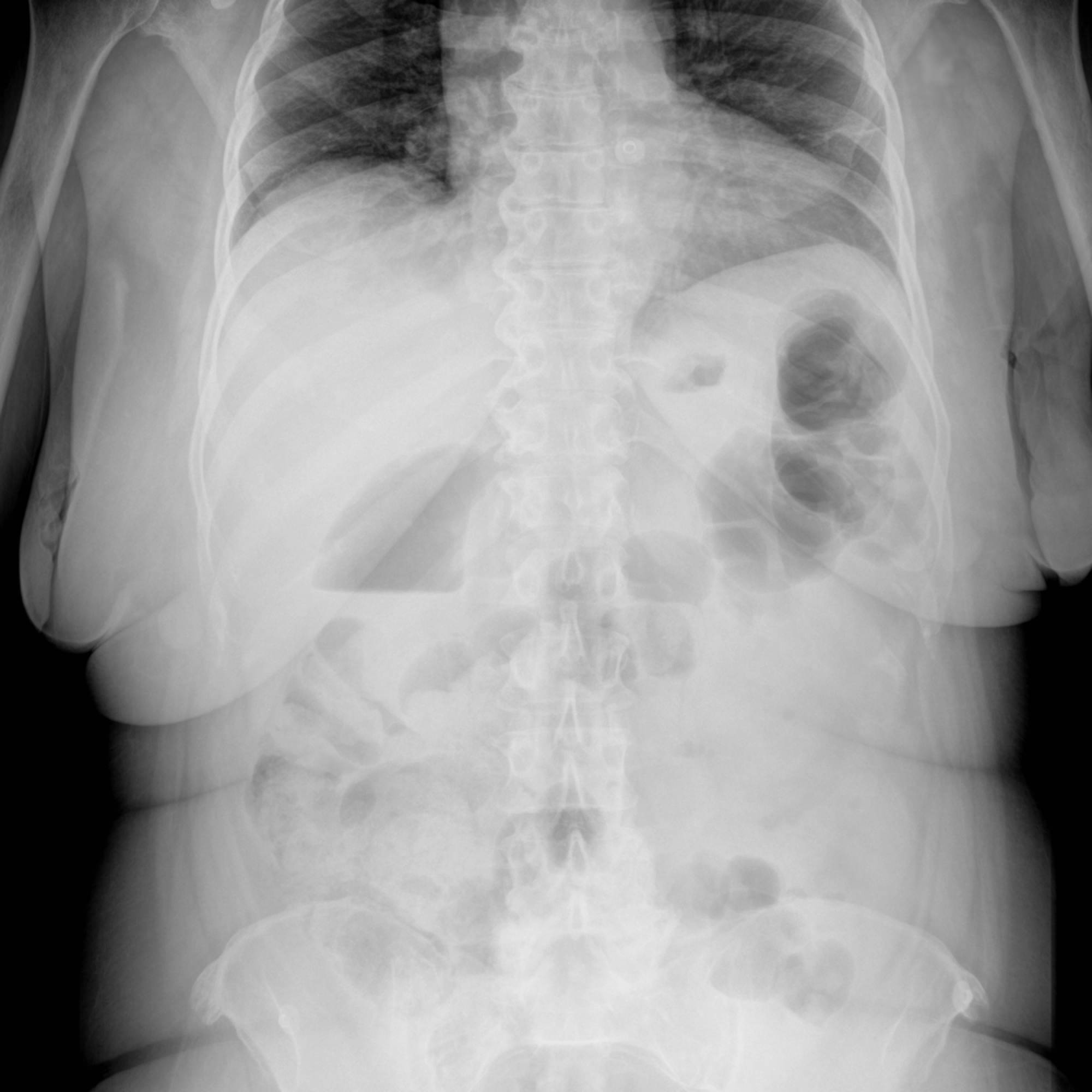
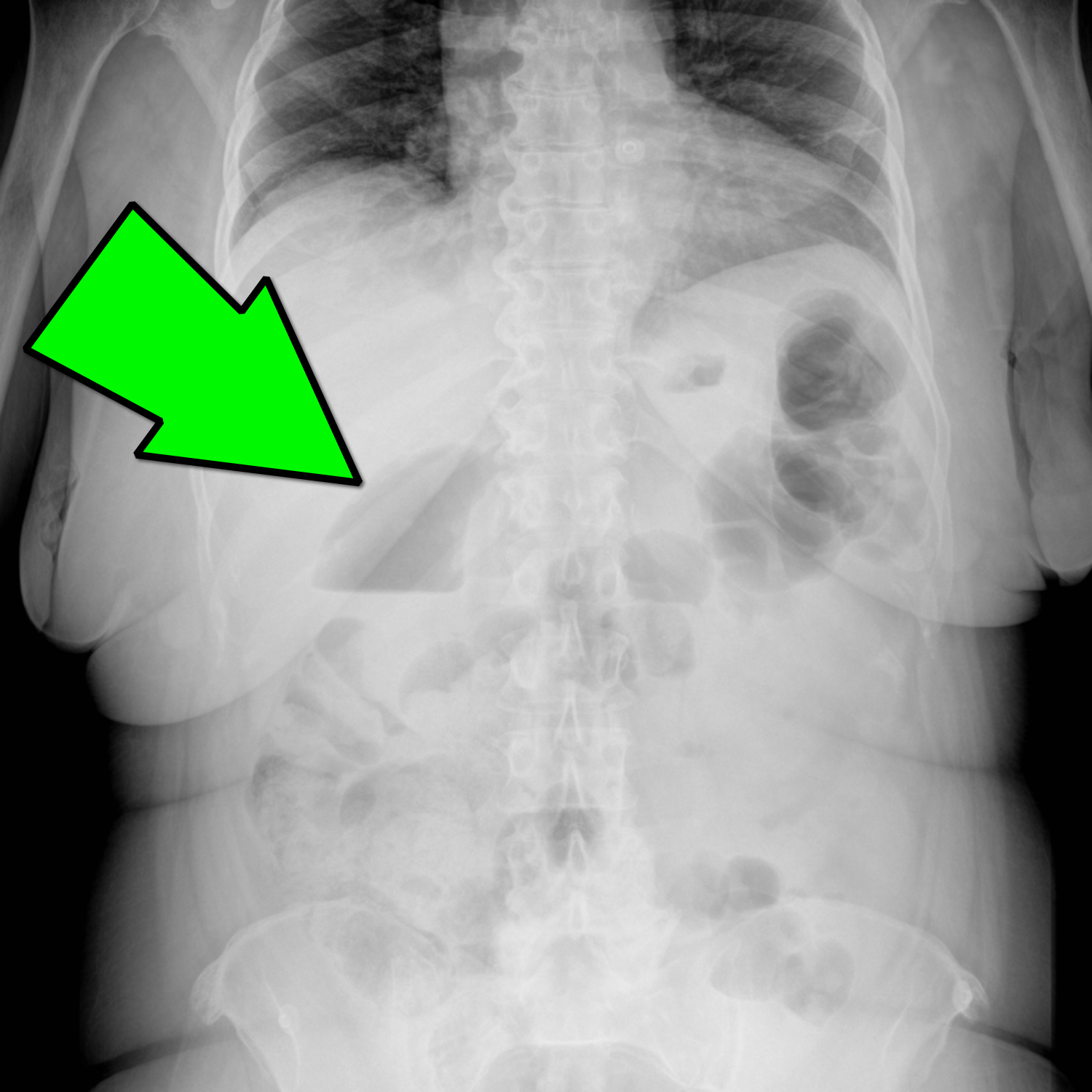
Emphysematous Cholecystitis
Emphysematous Cholecystitis
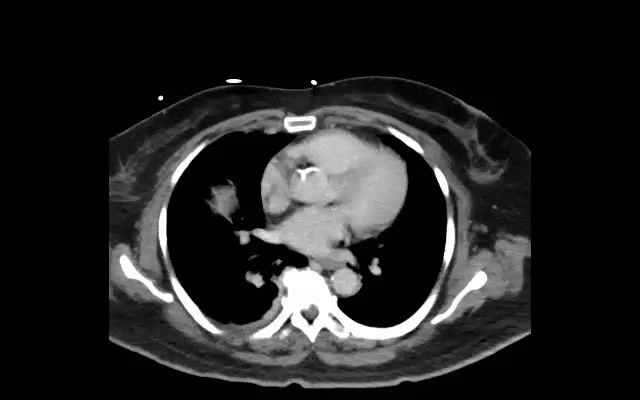
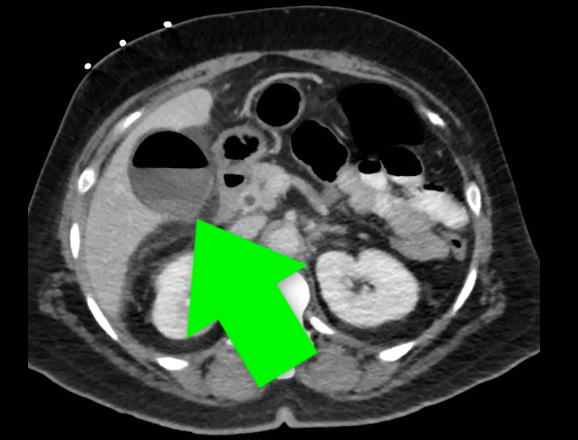
Carrascosa MF, et al. Emphysematous Cholecystitis. CMAJ.10 Jan 2012; 184(1): E81
Category: Cardiology
Posted: 9/29/2013 by Ali Farzad, MD
(Updated: 3/10/2014)
Click here to contact Ali Farzad, MD
The primary goal in management of STEMI is rapid coronary revascularization. STEMI's are occasionally complicated by ventricular fibrillation (VF) arrest. High quality chest compressions and early defibrillation will improve survival. But what can be done in cases where conventional ACLS measures fail and patients have shock-refractory VF?
Some have suggested that emergent PCI with ongoing CPR en route may be beneficial. This option may be considered in close consultation with cardiology if the arrest is thought to be driven by ongoing ischemia and infarction. However, definitive data is lacking and this has only been described in a handful of case reports.
There may also be a role for venoarterial ECMO to aid in perfusion of vital organs and limit the risk of multisystem organ failure. The ECMO circuit can also help facilitate therapeutic hypothermia after the culprit vessel(s) is revascularized and rhythm is restored.
Chances for survival are highest in younger patients, those that do not have chronic illnesses, and those who received immediate CPR after arrest.
Summary:
Consider emergent consultation for salvage PCI and ECMO in select cases of shock-refractory ventricular fibrillation associated with STEMI
Want more emergency cardiology pearls? Follow me @alifarzadmd
A recently published case report (attached) presents a fascinating case where salvage PCI and ECMO were used for shock-refractory VF. The patient survives with good neurological outcome. It highlights the multidisciplinary cooperation and resources necessary to utilize these heroic practices.
Brown DFM, Jaffer FA, Baker JN, Gurol ME. Case records of the Massachusetts General Hospital. Case 28-2013. A 52-year-old man with cardiac arrest after an acute myocardial infarction. N Engl J Med. 2013;369(11):1047–1054. doi:10.1056/NEJMcpc1304164.
Category: Orthopedics
Keywords: Stress fractures, runners (PubMed Search)
Posted: 9/28/2013 by Brian Corwell, MD
Click here to contact Brian Corwell, MD
Prior fracture represents the strongest predictor of stress fracture in both sexes
For girls: Low body mass index, (<19), late menarche (age 15 or older), previous participation in gymnastics and dance.
For boys: increased number of seasons.
Participation in basketball appears protective in boys.
This may represent a modifiable risk factor for stress fractures.
Tenforde AS, Sayres, LC, et al. Identifying sex-specific risk factors for stress fractures in Adolescent Runners. 2013
Category: International EM
Keywords: Trauma, Global, MVA (PubMed Search)
Posted: 9/25/2013 by Andrea Tenner, MD
Click here to contact Andrea Tenner, MD
General Information:
Relevance to the EM Physician:
Although road traffic injury deaths have decreased in some high-income countries, by 2030 it is predicted that they will be the fifth leading cause of death worldwide, and the seventh leading cause of Disability Adjusted Life Years (DALY) lost.
Bottom Line:
Developing trauma and acute care capacities in low and middle-income countries is of utmost importance to mitigate the global burden of injuries.
University of Maryland Section of Global Emergency Health
Author: Walid Hammad, MB ChB
World Health Organization, Global status report on road safety, 2013
World Health Organization, Injuries Violence The Facts, 2010
Category: Critical Care
Keywords: Procalcitonin, Upper respiratory infections, antibiotics (PubMed Search)
Posted: 9/24/2013 by Feras Khan, MD
(Updated: 12/16/2025)
Click here to contact Feras Khan, MD
Background:
Clinical Question:
Meta-analysis:
Conclusions:
Limitations:
Bottom Line:
Clinical Outcomes Associated With Procalcitonin Algorithms to Guide Antibiotic Therapy in Respiratory Tract Infections
Philipp Schuetz, MD, MPH; Matthias Briel, MD, MSc; Beat Mueller, MD
JAMA. 2013;309(7):717-718. doi:10.1001/jama.2013.697.
http://jama.jamanetwork.com/article.aspx?articleid=1653510
Category: Visual Diagnosis
Posted: 9/23/2013 by Haney Mallemat, MD
Click here to contact Haney Mallemat, MD
27 year-old female with no past medical history presents with sudden onset of left lower quadrant pain. What's the diagnosis?
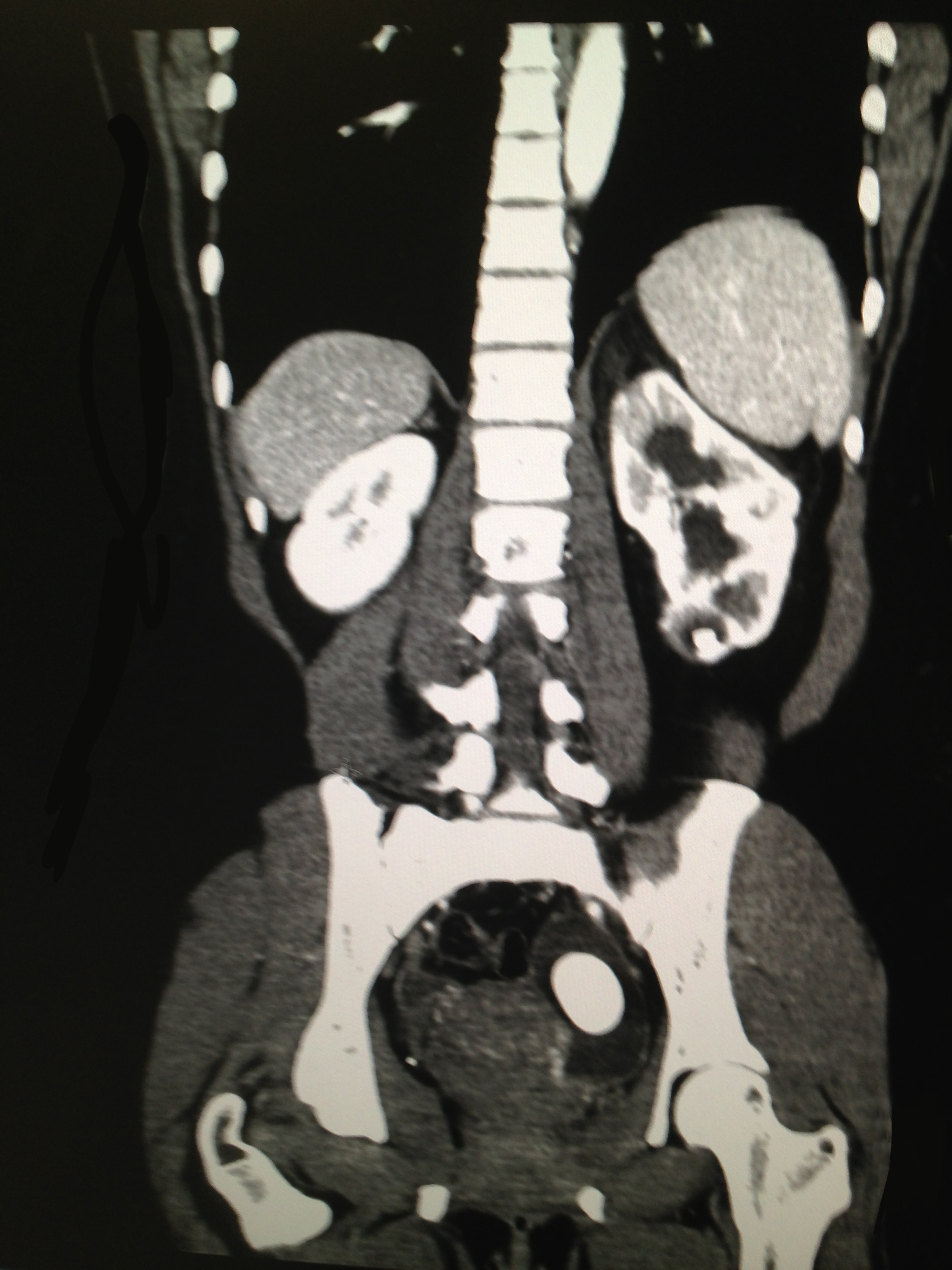
Large left-sided ureterolithiasis with hydronephrosis
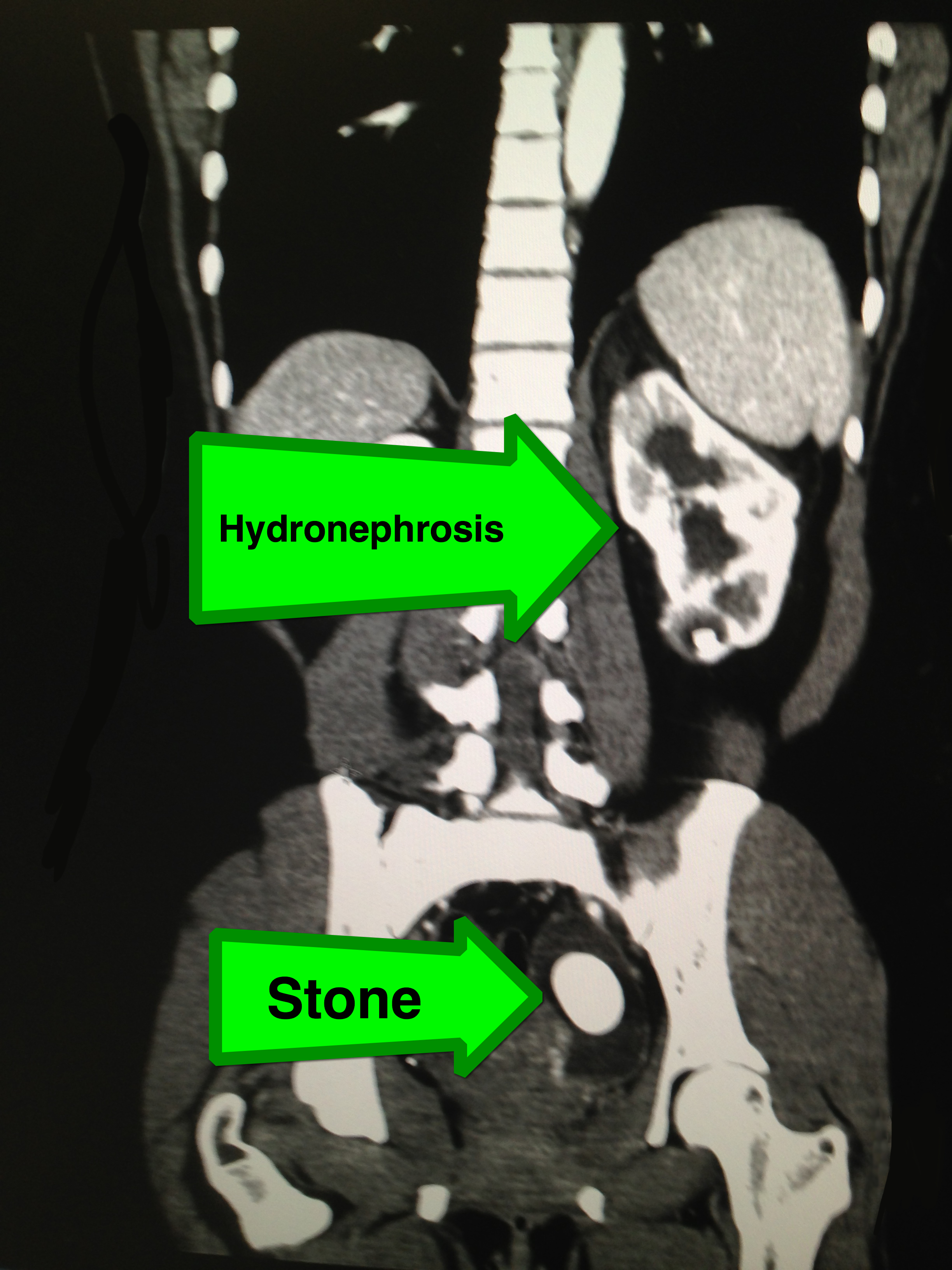
Category: Cardiology
Keywords: Bundle branch block (PubMed Search)
Posted: 9/22/2013 by Semhar Tewelde, MD
Click here to contact Semhar Tewelde, MD
Is RBBB More Indicative of Large Anteroseptal MI?
Strauss DG, Loring Z, Selvester RH, et al. Right, But Not Left, Bundle Branch Block Is Associated With Large Anteroseptal Scar. JACC. Sept 2013; 62(11): 959-967.
Category: Obstetrics & Gynecology
Keywords: Morning Sickness, Pregnancy (PubMed Search)
Posted: 9/21/2013 by Michael Bond, MD
Click here to contact Michael Bond, MD
Treatment:
Consider these therapies the next time you see a pregnant with persistent nausea and vomiting in her 1st
--Yemi
Niebyl, Jennifer MD. Nausea and Vomiting in Pregnancy. The New England Journal of Medicine. Oct 2010. 363:16.
Category: Pediatrics
Keywords: orthopedics, compartment syndrome (PubMed Search)
Posted: 9/20/2013 by Jenny Guyther, MD
(Updated: 12/16/2025)
Click here to contact Jenny Guyther, MD
We have learned how to diagnose compartment syndrome in adults, but how do you determine the early warning signs in a nonverbal or even frightened child?
Rising compartment pressures are related to increasing anxiety and agitation in children. A Boston study in 2001 showed that increasing pain medication requirements were detected 7 hours earlier than a vascular exam change. 90% of the patients with compartment syndrome in this study reported pain, but only 70% had another ‘P” (pallor, parasthesia, paralysis or pulselessness).
This has led to the proposal of the 3 “A”s for early identification of compartment syndrome in children: increasing anxiety, agitation and analgesia requirement.
Noonan and McCarthy. Compartment Syndrome in Pediatric Patients. Journal of Pediatric Orthopedics. Vol 30. No 2. March 2010.
Category: International EM
Posted: 9/18/2013 by Walid Hammad, MD, MBChB
Click here to contact Walid Hammad, MD, MBChB
General Information:
· The coming of the Affordable Care Act (ACA) is designed to shift patient care from episodic encounters to continuous community based partnerships.
· Elsewhere in the world, community health workers (CHWs) have been used effectively to improve health outcomes, reduce heath care costs and create jobs in infectious disease (TB, HIV), maternal child health and chronic disease management.
· CHWs are paid, full time lay provider members of community health systems.
o Sub-Saharan Africa is training, deploying and integrating one million CHWs into the health system via a targeted campaign.
o Brazil’s CHWs are part of family health teams that care for 110 million people.
o India employs 600,000 CHWs paid through a fee-for-service system for primary care functions.
· CHWs cost less, reduce readmissions and help address root causes of preventable chronic disease while remaining embedded in the community helping to strengthen long-term community relationships.
Relevance to the EM Physician:
As frustration with non-compliant patients mounts and the impact of the ACA looms, CHWs integrated into American communities may be just the answer we haven’t yet considered to help reduce ED overcrowding and improve our patients’ outcomes.
University of Maryland Section of Global Emergency Health
Author: Emilie J.B. Calvello, MD, MPH
Singh,P. Chokshi, D. Community Health Workers – A Local Solution to a Global Problem. NEJM. 2013, 369: 894 – 896.
Category: Critical Care
Posted: 9/17/2013 by Mike Winters, MBA, MD
(Updated: 12/16/2025)
Click here to contact Mike Winters, MBA, MD
Peri-Intubation Cardiac Arrest
Heffner AC, Swords DS, Neale MN, Jones AE. Incidence and factors associated with cardiac arrest complicating emergency airway management. Resuscitation 2013. [Epub ahead of print].
Category: Visual Diagnosis
Posted: 9/16/2013 by Haney Mallemat, MD
Click here to contact Haney Mallemat, MD
8 year-old girl presents with dysphagia and drooling, Xray is shown. What’s the diagnosis (and where is it located)?
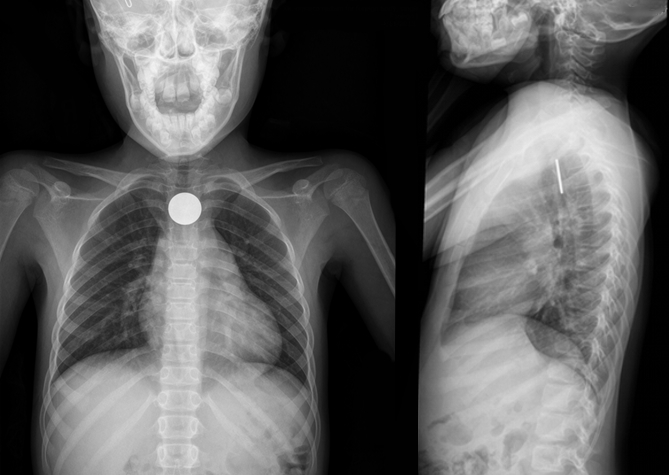
A coin located in the esophagus at the level of the cricopharyneus muscle
Foreign body (FB) pearls
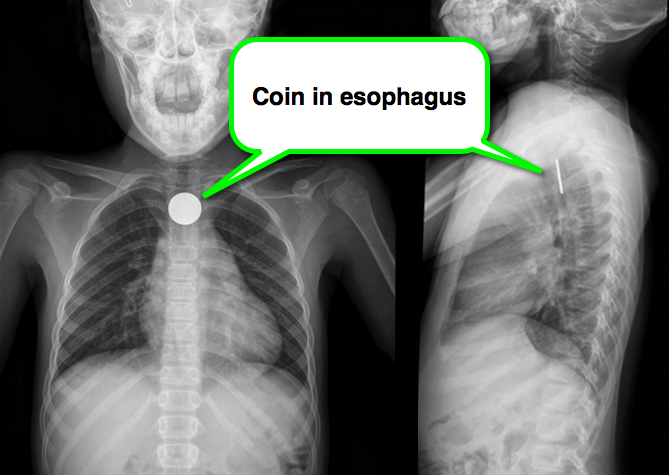
Kenton, Foreign Bodies in the Gastrointestinal Tract and Anorectal Emergencies, Emerg Med Clin N Am 29 (2011) 369–400
Category: Cardiology
Keywords: Acute Pericarditis, Colchicine (PubMed Search)
Posted: 9/15/2013 by Ali Farzad, MD
(Updated: 3/10/2014)
Click here to contact Ali Farzad, MD
Colchicine is known to be effective in treatment of recurrent pericarditis, but until recently its efficacy during the first attack of acute pericarditis has been uncertain.
A recent multicenter, double-blinded, RCT of patients with acute pericarditis found colchicine to be effective in reducing the rate of incessant or recurrent pericarditis (primary outcome), as well as the rate of hospitalization. Here are some highlights:
Bottom-line:
Colchicine is a safe and effective drug for the treatment of acute pericarditis. Consider adding colchicine to conventional therapies to reduce duration of symptoms, recurrences, and rate of hospitalization.
Imazio M, Brucato A, Cemin R, et al. A Randomized Trial of Colchicine for Acute Pericarditis. N Engl J Med. 2013 (.pdf attached)
Do you know the ECG findings of pericarditis and how to differentiate from other causes of diffuse ST-segment elevation? Check out these previous ECG videos to refresh your memory...
STEMI vs. Benign early repolarization vs. Pericarditis
Category: Orthopedics
Keywords: Basilar joint, thumb, arthritis, Basal joint grind test (PubMed Search)
Posted: 9/14/2013 by Brian Corwell, MD
Click here to contact Brian Corwell, MD
The thumb MCP joint is subject to arthritric changes.
Sx's of arthritis will frequently present with pain in a similar region to deQuervain's disease.
The basal joint grind test
Perform by stabilizing the triquetrum with your thumb and index finger and then dorsally subluxing the thumb metacarpal on the trapezium while providing compressive force with the opposite hand.
http://www.youtube.com/watch?v=oEJH7KFGx_Y
Category: Airway Management
Posted: 9/13/2013 by Rose Chasm, MD
(Updated: 12/16/2025)
Click here to contact Rose Chasm, MD
2012 PREP Self-Assessment. American Academy of Pediatrics
Category: Toxicology
Keywords: hypoglycemia, overdose, diabetes, antidiabetic (PubMed Search)
Posted: 9/10/2013 by Bryan Hayes, PharmD
(Updated: 9/12/2013)
Click here to contact Bryan Hayes, PharmD
With several new diabetes medications available, it is important to know which ones are likely to cause hypoglycemia after overdose. Based on mechanism of action and reported cases, the likelihood of hypoglycemia after overdose is listed below by drug class.
Keep in mind that other drugs can interact with antidiabetics resulting in hypoglycemia. This table applies only to single agent ingestion/administration.
| Drug Class | Examples | Hypoglycemic Potential |
|---|---|---|
| Insulins | Glargine, Aspart, Detemir | High |
| Sulfonylureas | Glyburide, Glipizide | High |
| Meglitinides | Nateglinide, Repaglinide | High |
| Glucagon-Like Peptide-1 (GLP-1) Receptor Agonists | Exenatide | Low-Moderate |
| Alpha-glucosidase inhibitors | Acarbose, Miglitol | Low |
| Thiazolidinediones | Rosiglitazone, Piaglitazone | Low |
| Biguanides | Metformin | Low |
| Dipeptidyl Peptidase 4 (DPP-4) Inhibitors | Sitagliptin, Saxagliptin | Low |
Bosse GM. Chapter 48. Antidiabetics and Hypoglycemics. In: Bosse GM, ed. Goldfrank's Toxicologic Emergencies. 9th ed. New York: McGraw-Hill; 2011. http://www.accesspharmacy.com/content.aspx?aID=6514172. Accessed September 10, 2013.
Follow me on Twitter (@PharmERToxGuy)
Category: International EM
Keywords: climate, infectious, globalization, population, disease (PubMed Search)
Posted: 9/11/2013 by Andrea Tenner, MD
Click here to contact Andrea Tenner, MD
Background Information:
A recent review article in NEJM evaluated what effects globalization and climate change can be expected to have on human health. If global population increases and temperatures continue to rise, diseases that were once limited by either remoteness or climatologic regions may have new geographical spread.
Pertinent Conclusions:
There are three primary ways which climate change may be expected to affect health:
- Primary: Direct biologic consequences (i.e. heat waves, extreme weather events, air pollution)
- Secondary: Risks caused by process changes (i.e. decreased crop yields, tropical vectors with increased spread)
-Tertiary: More diffuse effects (mental health issues in failed farmers, conflict due to scarce water)
Bottom Line:
No matter what your views are on the causes, the current trend is that the overall climate is getting warmer and human population is increasing. Anticipation of possible consequences is key to planning for the future.
University of Maryland Section of Global Emergency Health
Author: Andi Tenner, MD, MPH
McMichael AJ. Globalization, Climate Change, and Human Health. N Engl J Med 2013; 368:1335-1343.
Category: Critical Care
Keywords: critical care, necrotizing pneumonia, infectious disease, pulmonary (PubMed Search)
Posted: 9/5/2013 by John Greenwood, MD
(Updated: 9/10/2013)
Click here to contact John Greenwood, MD
Necrotizing Pneumonia
Necrotizing pneumonia is a rare, but potentially deadly complication of bacterial pneumonia.
It is characterized by the finding of pneumonic consolidation with multiple areas of necrosis within the lung parenchyma. Necrotic foci may coalesce, resulting in a localized lung abscess, or pulmonary gangrene if involving an entire lobe.
Most common pathogens: S. aureus, S. pneumoniae, and Klebsiella pneumonia.
Others include S. epidermidis, E. coli, Acinetobacter baumannii, H. influenzae and Pseudomonas.
Contrast-enhanced chest CT is the diagnostic test of choice and is also helpful in evaluating for parenchymal complications.
Empiric antibiotic therapy should include:
Consider an early surgical evaluation for the patient with necrotizing pneumonia complicated by septic shock, empyema, bronchopleural fistula, or hemoptysis.
Reference
Tsai YF, Ku YH. Necrotizing pneumonia: a rare complication of pneumonia requiring special consideration. Curr Opin Pulm Med. 2012 May; 18(3):246-52.
Category: Visual Diagnosis
Posted: 9/8/2013 by Haney Mallemat, MD
(Updated: 9/9/2013)
Click here to contact Haney Mallemat, MD
This week's case is challenging, but very interesting...
An elderly patient presents with a history of significant weight loss and chronic constipation; abdominal Xray is below. What's the diagnosis? (Hint: why is the right kidney and psoas muscle so well defined?)
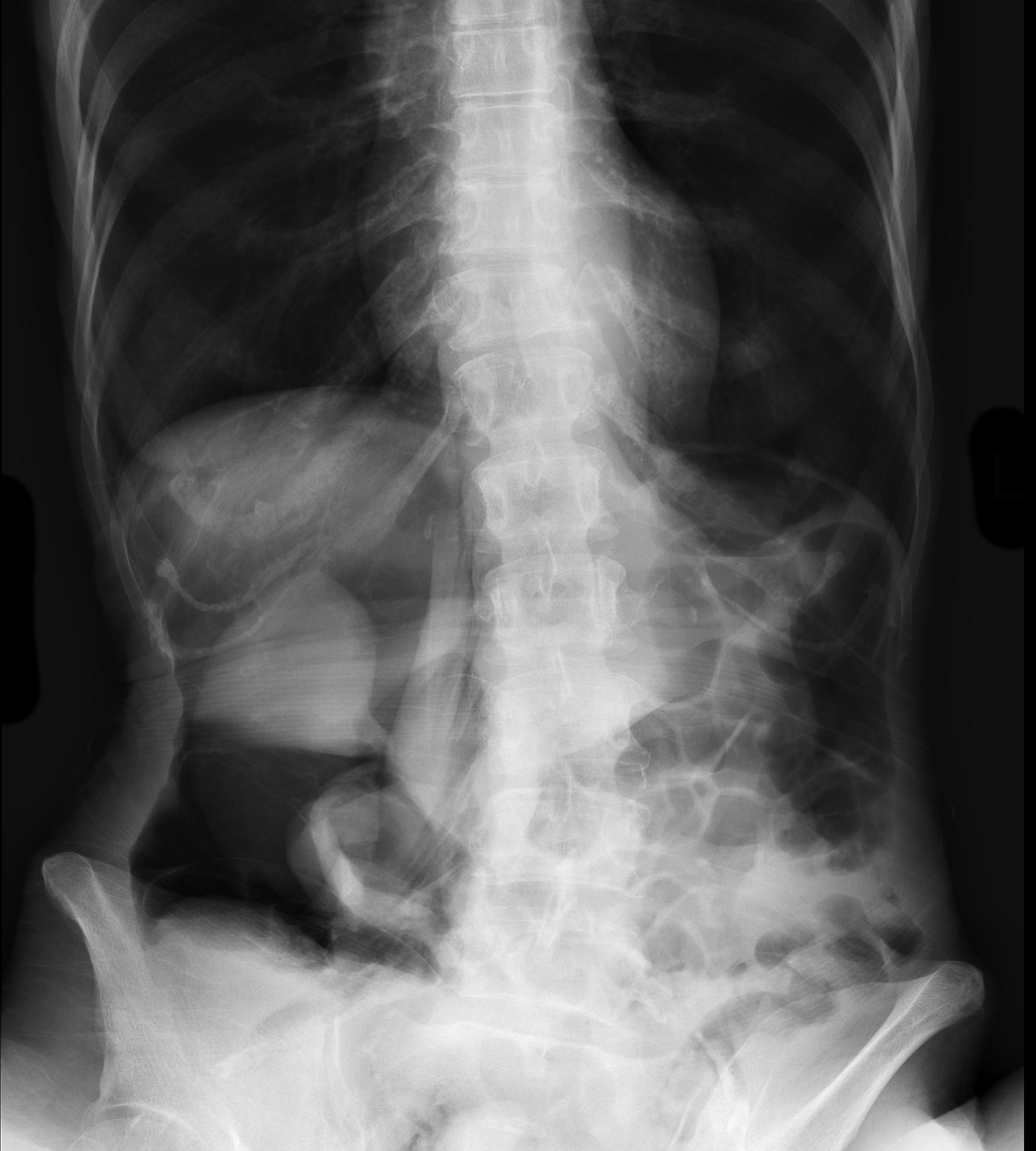
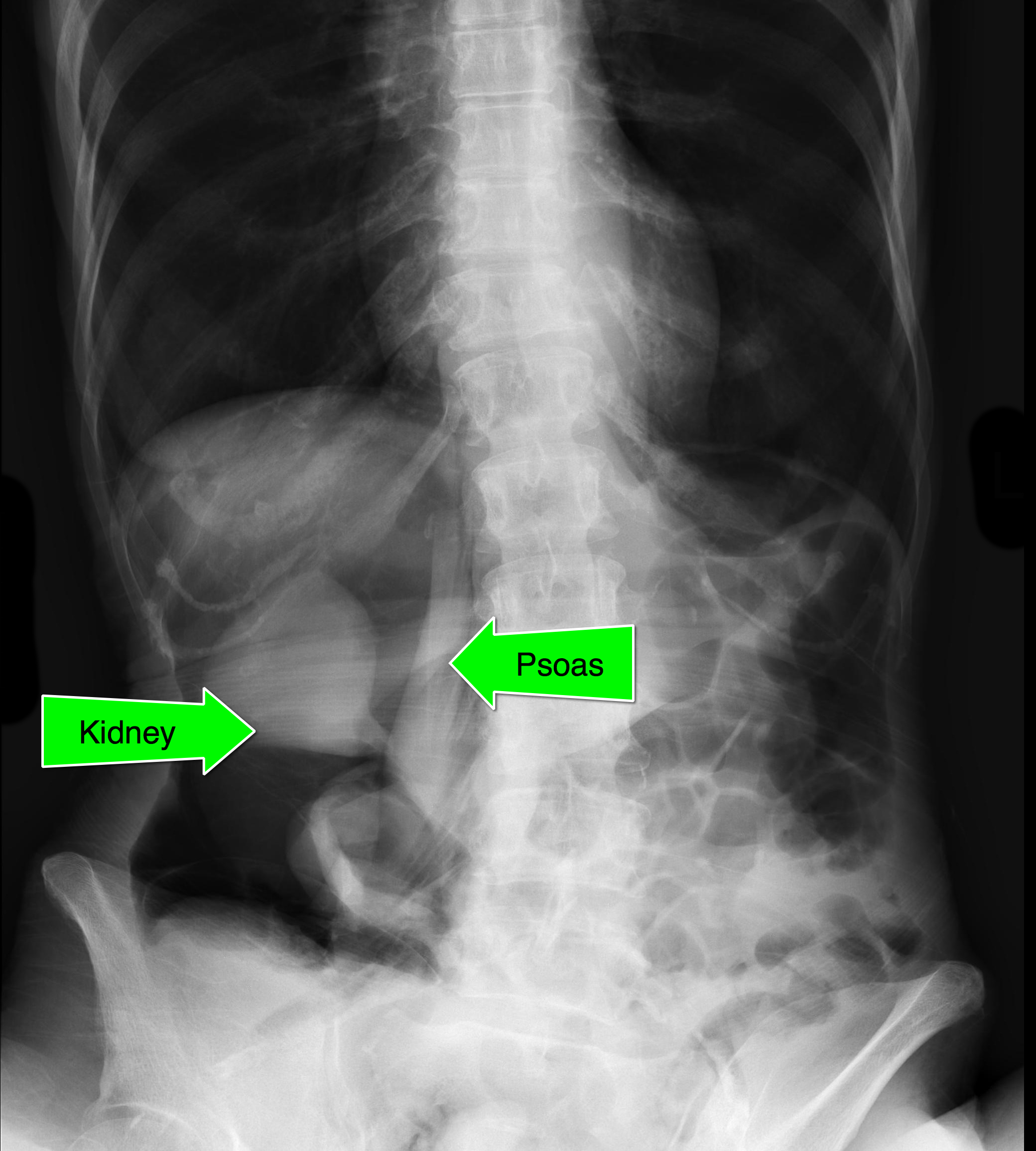
Follow me on Twitter (@criticalcarenow) or Google+ (+criticalcarenow)
